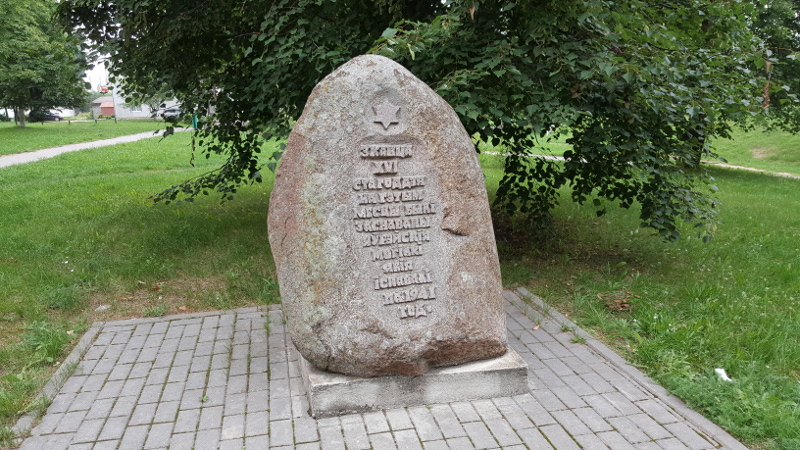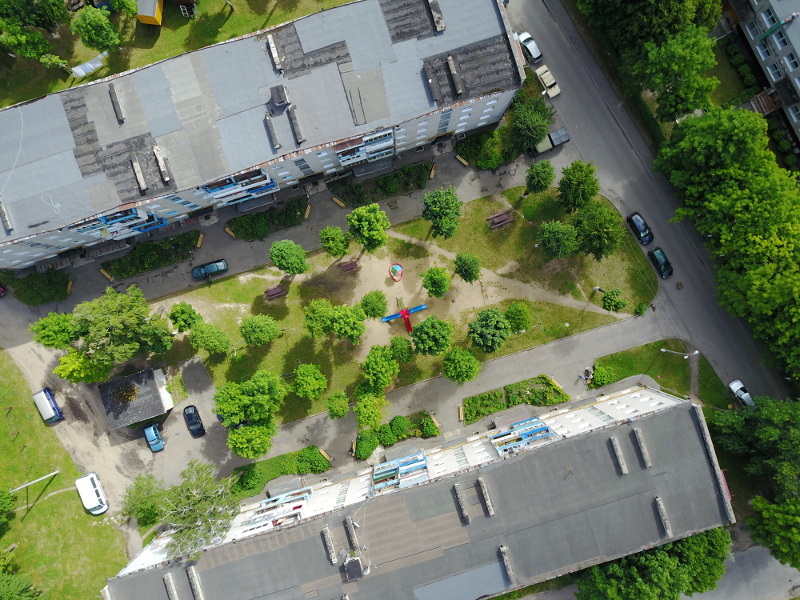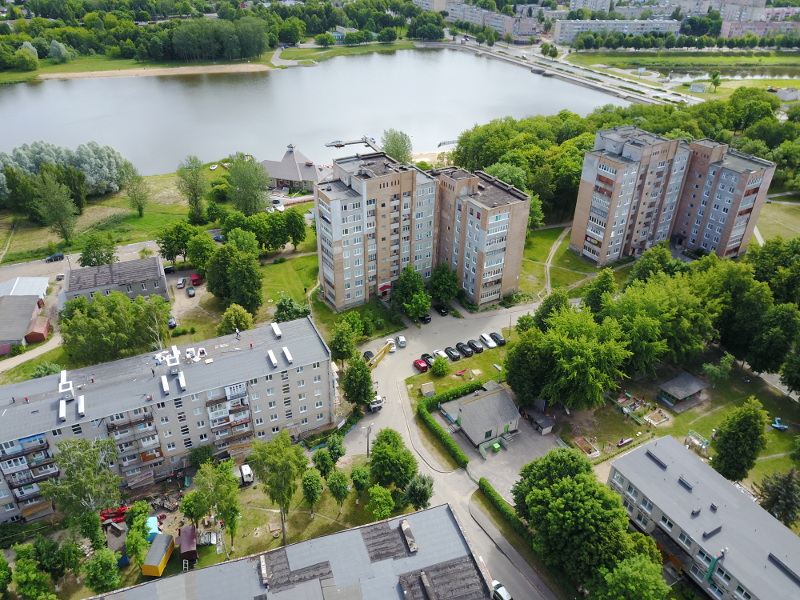
 Alternate names: Lida [Rus, Yid, Pol, Bel], Lyda [Lith], Russian: Лида. Belarusian: Ліда. לידע - Yiddish: 53°53' N, 25°18' E, 55 miles S of Vilnius (Vilna), 29 miles NW of Navahrudak (Nowogródek). 1900 Jewish population: 5,294.
Alternate names: Lida [Rus, Yid, Pol, Bel], Lyda [Lith], Russian: Лида. Belarusian: Ліда. לידע - Yiddish: 53°53' N, 25°18' E, 55 miles S of Vilnius (Vilna), 29 miles NW of Navahrudak (Nowogródek). 1900 Jewish population: 5,294.
- Shtetlink,
- Yizkor Sefer Lida (Tel Aviv, 1970).
- JewishGen-erosity Projects
(1): Lida District Records - Welcome to the Lida Site - Eilat Gordin Levitan [Aug 2015]
- History of Lida - JewishGen KehilaLinks [Aug 2015]
- The Lida Ghetto - Museum of Family History [Aug 2015]
- Tuvia Bielski - Wikipedia, the free encyclopediaHolocaust Memorial Center [Aug 2015]
- Lida Holocaust Memorial Foundation [Aug 2015]
- Holocaust Controversies: The Holocaust in Lida [Aug 2015]
- Who Killed Lida s Jewish Intelligentsia? [Aug 2015]
- Town images and links. Formerly in Lida uezd, Vilna guberniya. video. video. [March 2009]
| Before WWI (c. 1900): | Lida | Vilna | Russian Empire | |
| Between the wars (c. 1930): | Lida | Nowogródek | Poland | |
| After WWII (c. 1950): | Soviet Union | |||
| Today (c. 2000): | Belarus | |||
Jewish history: Jews first settled in Lida in the mid-16th century and obtained permission to construct a synagogue from King Stefan Batory in 1579. The building was decimated and rebuilt with permission of King Wladyslaw Vasa in 1630. By 1817, the Jewish Community of Lida numbered 567, nearly three-quarters of the total population of the city at the time. Lida had a brick synagogue.During WWI, the Germans captured Lida; both Jews and non-Jews were forced into labor. Soon after the German Occupation ceased in Winter 1917, the Bolsheviks entered the city. In 1919, Polish soldiers entered Lida; and a pogrom slaughtered 39 Jews. Between the wars was a short period of economic growth. 12 fully-functioning synagogues existed. 1931 Jewish population was 6,335 and at the start of the Holocaust nearly 8,500. In Autumn 1939, the Red Army moved in and annexed Lida to Grodno District of the Byelorussian SSR, part of the Soviet Union. Yet again, the Jews were oppressed and all cultural aspects of the community supressed. The Soviets imprisoned surrounding Jews in Lida. In June 1941, the Germans severely damaged the city. By December , a ghetto was created in the suburbs of Lida. castle.
- David ben Aryeh Leib of Lida (ca. 1650-1696), Ashkenazi rabbi
- Yitzchak Yaacov Reines rabbi of Lida and founder of Mizrakhi Jewish religious Zionist movement
"Starting from the Spring of 2001, the Jewish Community of Belarus worked closely with the residents of Lida to erect a memorial commemorating the thousands of Lida Jews that perished in the Holocaust. In Autumn of 2003, an unveiling ceremony which involved 400 occurred. Now, visitors and residents alike can take a visit to this memorial, which properly honors all of those innocent victims of World War II." Wikipedia.
exhibition of names, dates inscribed on the gate posts, and photos of gates in front each of six to seven Lida society burial plots in the New York metro area. Source: This email address is being protected from spambots. You need JavaScript enabled to view it.. Note: Ada Green, part of LitvakSIG's Lida District Research Group, indexed all 1,249 burials in these various Lida landsmanshaft plots that continue to be searchable in the JewishGen Online Worldwide Burial Registry (JOWBR). [May 2013]
JOWBR Landsmanshaft:
-
Roselawn Avenue Cemetery, Toronto, Canada Mount Sinai Memorial Park, North York, Canada Mt. Zion Cemetery, Queens, USA Mt. Lebanon Cemetery, Queens, USA Beth David Cemetery, Elmont, USA Beth Moses Cemetery, Pinelawn, USA Mt. Carmel Cemetery, Queens, USA Beth David Cemetery, Elmont, USA New Montefiore Cemetery, Pinelawn, USA
MASS GRAVE:
- On May 7, 1942 the ghetto was sealed and on the 8th nearly 6,000 were taken to a military firing range, where they were shot and piled in pre-made grave pits. About 1,500 educated Jews remained in the ghetto, swollen by incoming refugees. A few groups secretly escaped the city and hid in the forests until the city was liberated in 1944, but the rest were murdered on September 18, 1943. Holocaust memorial [February 2010]
CEMETERY:
photos of the massacre site of several thousand Jews on March, 8, 1942, in 1942-43, and 1941-1942 and the monuments erected in 1967and 2002. [March 2009]
Old postcards including one of the former cemetery. Photo of last gravestone in Lida. Photo and photo of cemetery. [September 2002]
Photos of the cemetery, now a park. "Right after the occupation of the city of Lida by the Germans, the liquidation of the Jewish Cemetery began. Farmers from the neighborhood began to pasture their cows and later began to the smash gravestones and take stones for their private use. It went on like that also after the war with no interference. In the mid-1950s, the city council forbade the few Jewish families that resided in Lida to bury their dead there. With no other alternative, they had to carry them to the cemetery in the town Ivye. The fast liquidation of the cemetery in Lida started at the beginning of the 60s. First, they destroyed the section closest to the shore of Lidzhika River with digging machinery. They dug [foundations] and built warehouses and various constructions for boats, speedboats and services for the artificial lake that was made with the waters of the Lidzhika River at the end of Postovska Street. After that, they also destroyed the section of the cemetery bordered on Postovska Street and broke the gravestones that still remained. All of this was done despite the protest of the Jews who still lived in the city. Many human bones were scattered on the surface of the ground. The Jews picked them up into a sack and buried them in the cemetery section that still survived at that time. At the end of January 1966, only a few gravestones were left at the center of the cemetery and even those were destroyed later. Thus, the last remaining sign that evidenced the existence of a large and flourishing Jewish community in the city Lida was destroyed and obliterated." Source: yizkor [May 2001]
UPDATE: Belarus SIG Newsletter article. Scroll down to find cemetery and mass grave information and photo. [October 2003]
UPDATE: grave found: "While laying communication cables in the city of Lida, workers discovered what was later determined to be a Jewish grave dating back to 1872....A Jewish cemetery was once located in the center of Lida, but in the [1950s] it was destroyed by the Soviet government to make room for housing. Today, gravestones and human remains are frequently uncovered during construction projects. Several years ago, two headstones dating from the year 1605 were discovered, and were subsequently added to an existing Holocaust memorial. Rabbi Yitzchak Kofman of nearby Grodno together with members of Jewish community reburied the recently discovered remains ... The original gravestone, which was discovered on Saturday, will remain where it was found to serve as a memorial to the Jewish cemetery that once existed there." [March 2009]
Cemetery photos. [February 2010]
Eilat Gordin photos. [October 2014]
Photo of cemetery memorial stone [July 2016] and surroundings [June 2017] by This email address is being protected from spambots. You need JavaScript enabled to view it. (Nothing remains of the cemetery. Buildings have been erected on the site with a memorial stone in Russian.)




